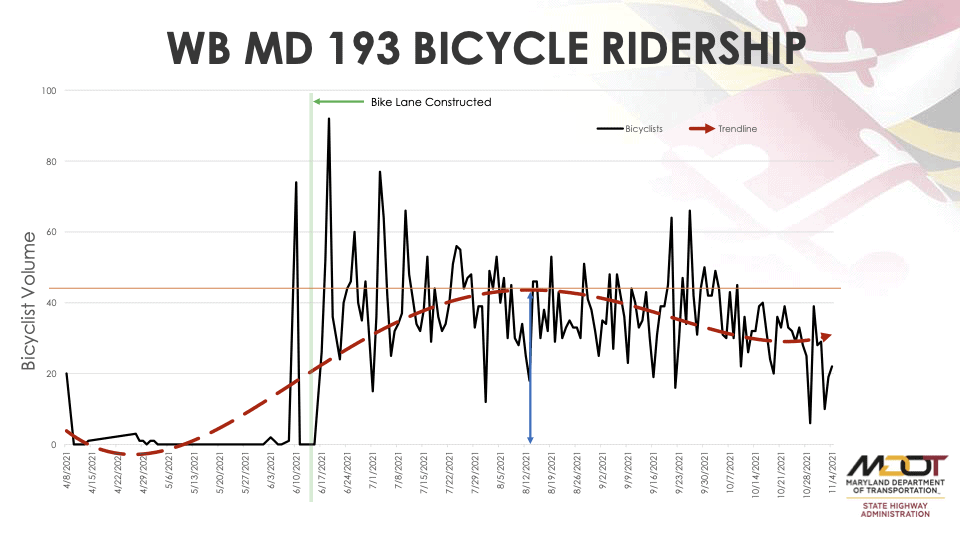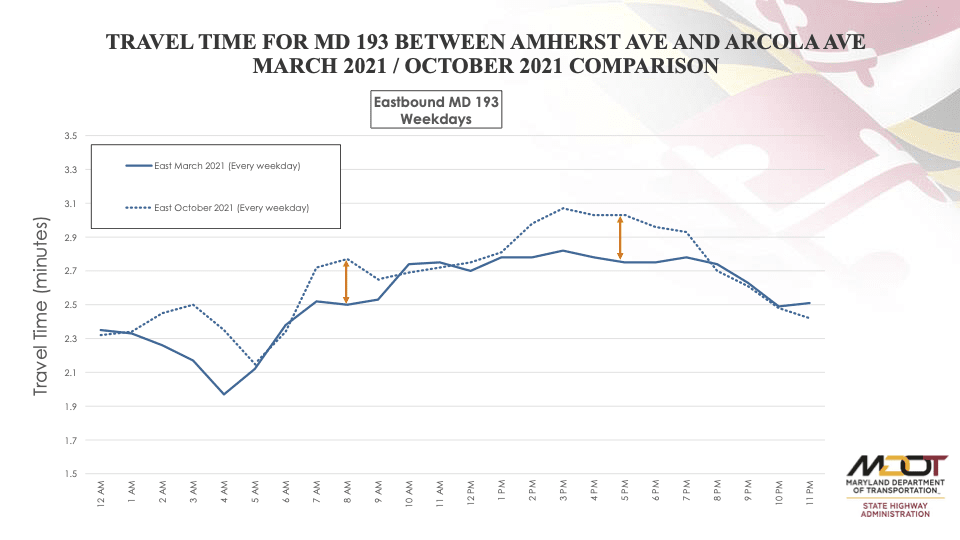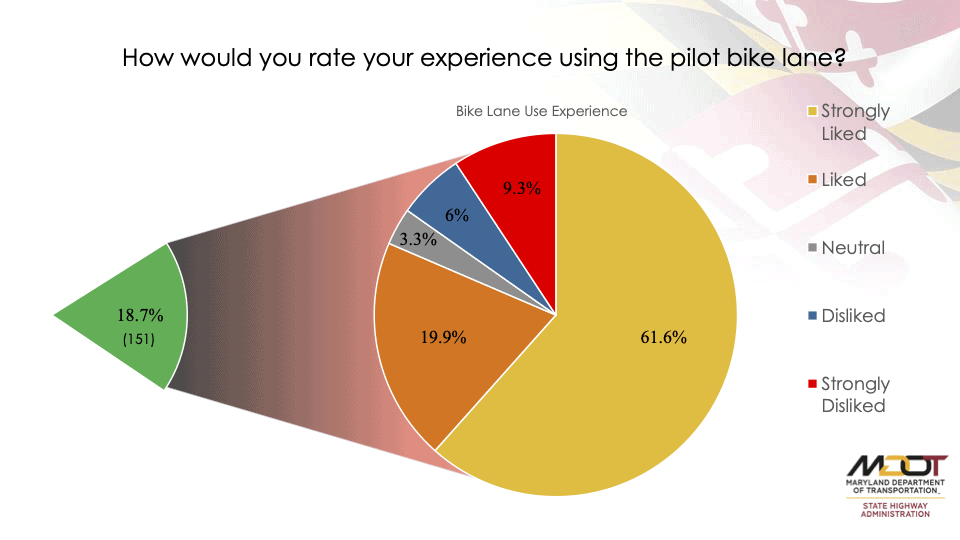Updates on the University Blvd Protected Bike Lane
In June 2021, after a successful push by advocates, the Montgomery County Council, and Maryland State Delegates/Senators, the Maryland State Highway Administration (“SHA”) installed protected bike lanes on a 1.35 miles stretch of University Boulevard in Wheaton as part of a 6-month experiment of repurposing car-only spaces to support safer biking and walking on State highways. In January 2022, SHA staff announced that despite all data demonstrating that the changes were a tremendous success, they have decided that protected bike lanes will not be returning to University Blvd.
For the pilot, SHA repurposed the curb travel lanes into bike lanes, marked with plastic bollards, lane striping and signage, leaving two lanes in each direction for car traffic. This established an 11 foot wide car-free space in each direction for people on bikes or using mobility devices. This space also served as a buffer between the sidewalks and travel lanes for much more comfortable walking and wheeling along this busy State road. This short segment of protected bike lanes made for a safe connection between the Sligo Creek Trail and the Wheaton Central Business District and its many restaurants, shops and offices. It also made getting to Northwood High School much safer from the west.

At a public meeting on January 26, 2022, SHA noted that with respect to all the data gathered during the six month pilot period, the pilot was a total success. Reducing driving lanes and adding bike lanes helped reduce car speeds to conform with the 35 mph limit. The pilot did not result in any significant traffic congestion on MD-193 in either direction, adding, at most, 15 seconds to travel the 1.35 miles by car at the busiest time of day. At the same time, the number of people using their bikes on University doubled compared to the months before the pilot was implemented, despite the fact that the treatment was only on a short segment of this road with relatively few destinations or bike network connections.

At the conclusion of the pilot In December 2021, the pilot installation was dismantled for easier snow plowing and SHA posted a survey to gauge public opinion on the pilot for two weeks. SHA mailed postcards to adjacent residents in Kemp Mill, but did not share the survey to the project’s email list or to the hundreds of supporters who submitted feedback between June 2021 and December 2021. At the January 26 meeting, SHA then announced that the poll results, not the data or written feedback collected during the pilot period, were the main deciding factor in whether to reinstall the protected bike lanes on any portion of University Boulevard.
Unsurprisingly, the poll showed that the pilot bike lanes were unpopular among people who did not use them, but the reason is not what you think. To minimize unsafe conflicts in the bike lanes, SHA closed a slip lane at Arcola Avenue which serves the Kemp Mill neighborhood. This closure did cause some car backups and became a point of controversy for some in Kemp Mill who felt they had not been consulted prior to the closure of the slip lane. For these Kemp Mill residents, the safety enhancements from the bike lanes were irrelevant because it took longer to turn onto University Blvd. For the 19% of respondents who reported using the lane at least once, 85% rated their experience as Strongly Liked, Liked, or Neutral.

All of the data gathered by SHA showed positive impacts from the pilot lanes. In addition, the data revealed no negative impacts to traffic flows on University Boulevard (see the full presentation here). However, SHA seemed to ignore all of the data and written feedback gathered during the pilot period and decided to rely solely on the responses in it’s online poll when considering next steps on University Boulevard. The poll, mainly distributed to residents in the Kemp Mill neighborhood, had a large majority of responses from people who never used the lanes and had a negative reaction to the closure of the slip lane on Arcola Avenue. It was this poll that SHA relied on when making it’s decision to not put protected bike lanes on any section of University Boulevard. We feel that decision was incorrect and motivated by factors wholly unrelated to the merits of the pilot lanes themselves.
SHA did note in the January meeting that they were open to pilot treatments on other State Highways. So, if you have an idea for a State Highway where you believe a protected bike lane could be a success, we urge you to suggest it in an email to:
- SHA administrator Tim Smith (timsmith2@mdot.maryland.gov) and the SHA District 3 office (dgunn@mdot.maryland.gov); &
- Your state Delegates and Senators (https://mgaleg.maryland.gov/mgawebsite/Members/District)
Show SHA and your elected representatives that you disagree with the justification for not allowing the protected bike lanes on any portion of University Boulevard. Tell them you support more protected bike lanes on State Highways to make walking, biking and use of all mobility devices safer along our busiest roads.
You must be logged in to post a comment.